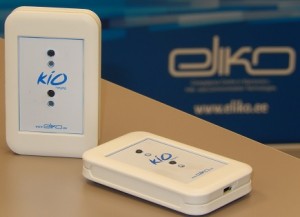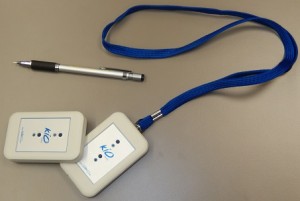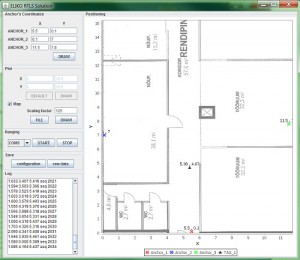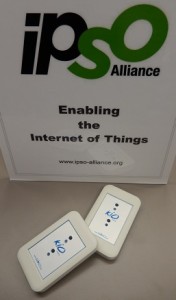 IPv6 Enabled Indoor Positioning System
IPv6 Enabled Indoor Positioning System
Contestants: Dr. Alar Kuusik, M.Sc Asfak Rahman
Affiliation: ELIKO
Semi-Finalist
Summary
ELIKO’s wireless positioning system kio is targeting indoor applications where both accuracy and low cost are important. kio is utilizing both Ultra-Wide Band (UWB) radio communication technology as well as the Time-of-Flight (ToF) distance measurement technique. While the localization accuracy of widely used WiFi-pattern fingerprinting can vary by several meters, kio’s positioning error is below 30 cm (1 ft). Until very recently, such superior performance was achievable only with high-end UWB systems, carrying the price tag of tens of thousands of dollars and requiring costly cable installations for the receiver synchronization. Because we are using the latest technologies, the kio system’s price will start at approximately $1,000 USD and it does not require any infrastructure installations.

Asfak Rahman and Alar Kuusik from ELIKO present “Indoor Positioning System”
The kio system contains anchors for ToF trilateration, nodes for moving objects, a network border router and optional wireless network monitors. It is possible to achieve a node ranging rate of over 10Hz that is perfect for mobile robot control. Tags and anchors using radio modules that operate in 3.5-6.5GHz frequency range are available from ELIKO. Communication between radios is based on the IEEE 802.15.4-2011-UWB MAC standard, which supports both ranging messages (special radio packets for distance measurements based on ToF delays) and IPv6-compliant, conventional payload data packets. On board ARM Cortex-M3 microcontrollers run Contiki 6LoWPAN software implementation, which supports RPL routing. The prototype’s border router system is based on a Raspberry Pi embedded computer. The border router collects the node position data and forwards it over the IPv6 tunnel to a remote web server. The kio node’s hardware also includes a 16-bit, 3D accelerometer and gyroscope. The main application fields for the kio system include indoor robot navigation and warehousing. In the future, the device also could be used as an IPv6-compliant, wearable safety device for elderly people in order to provide a more accurate position in case of emergencies.
How does “IPv6 Enabled Indoor Positioning System” use Internet Technology?
The tracking object contains a tag that performs a ranging algorithm (ToF) with 3 anchors within communication range and finds its relevant distance between the anchors. All communications at this stage happen based on the IEEE 802.15.4-2011 MAC standard with ranging bits in the PHY header of UWB radio. Each time a tag collects ranging data from its anchors, it sends a UDP packet to our remote server’s IPv6 address. These IP packets are forwarded to the border router through anchors in a route-over-IP manner. We have a Raspberry-Pi that operates as a border router. It has two interfaces – USB-to-Serial which connects to a UWB device and Ethernet for internet connectivity. The Raspberry-Pi is connected to our remote server over an IPv6 tunnel. When Tag’s IPv6 packet reaches the remote server, the web server runs a trilateration algorithm and plots the current coordinates of the tag in a location map. Usage of IP makes our system remotely controllable and easy integrated onto the web.
Why did you choose to invent your prototype? What problem do you see that it can solve?
Today’s indoor positioning systems are inaccurate or too expensive for many interesting applications including 2D (and especially 3D) autonomous machine navigation, human tracking for home/hospital safety, and assistance for conventional rescuers and fire fighters. All those applications additionally need certain data exchanges – sensor data transmissions over wireless multihop communication chains and Internet channels to the remote data warehouses. It would be natural to use seamless IP-based data transfers, existing handy IP tools and proven routing mechanisms. However, existing UWB radio-based positioning systems do not provide communication capabilities. With our current developments, we hope to solve frequent needs for accurate indoor positioning and simultaneous communication with a single system.


What is the practical application of your invention for the everyday user?
All precise indoor positioning applications that additionally need medium speed data transmissions are one practical application of our invention. It will be especially useful for hospitals where RTLS systems are widely deployed. Due to very low radio transmission levels, the UWB communication is safer and produces less disturbances. The UWB peak signal level is a hundred-thousand times lower than what conventional IEEE802.15.4 narrow-band radios have and 10 million times below the power limits of WiFi. This technology is well suited for indoor navigation to provide assistance to people with special needs, as well as machines without special needs – low cost home service robots, for example.

Are there plans to produce your prototype for the marketplace, or is it already a product that can be purchased/obtained?
Our product is about to reach the market. It has been submitted for evaluation by select consumers in Europe and we are planning to start production later this year. Right now, early purchase requests are welcome via email to rtls@eliko.ee.
Why would you consider “IPv6 Enabled Indoor Positioning System” to be “innovative”?
To the best of our knowledge, this is the first IEEE802.15.4-2011 MAC based system implementation available that supports both ToF ranging and IPv6 based communication.
What would you like to see in the future for the Internet of Things? Why should more companies utilize IP?
We would like to see faster deployment of vehicle-to-vehicle communication technologies through IEEE802.11p radio. Our vision for the future is to see and promote different physical radios that utilize standard communication protocols like IP and not limit their usability to any propitiatory solutions. That enables all kind of services, like vehicle-to-vehicle communication technologies, IEEE802.11p radio, and Internet connected cars to bind into one single platform. Additionally, we would like to see these Internet connected cars being able to support firmware updates, to connect to factories for troubleshooting, and to be integrated with web services (traffic data, weather conditions, etc.). Regarding companies – M2M communication is de facto IP based today. We just have to wait until a majority of home appliances start to communicating. That truly will be IP communication.
